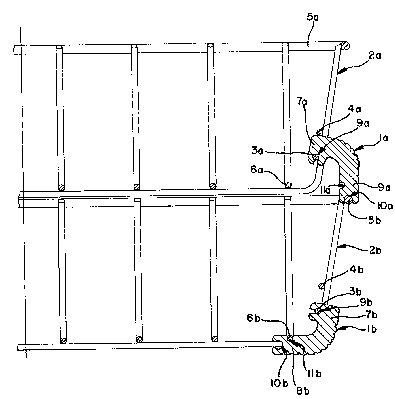Une partie des informations de ce site Web a été fournie par des sources externes. Le gouvernement du Canada n'assume aucune responsabilité concernant la précision, l'actualité ou la fiabilité des informations fournies par les sources externes. Les utilisateurs qui désirent employer cette information devraient consulter directement la source des informations. Le contenu fourni par les sources externes n'est pas assujetti aux exigences sur les langues officielles, la protection des renseignements personnels et l'accessibilité.
L'apparition de différences dans le texte et l'image des Revendications et de l'Abrégé dépend du moment auquel le document est publié. Les textes des Revendications et de l'Abrégé sont affichés :
| (12) Demande de brevet: | (11) CA 2053011 |
|---|---|
| (54) Titre français: | SYSTEME D'EMPILAGE DE PLATEAUX |
| (54) Titre anglais: | TRAY TRACKING SYSTEM |
| Statut: | Réputée abandonnée et au-delà du délai pour le rétablissement - en attente de la réponse à l’avis de communication rejetée |
| (51) Classification internationale des brevets (CIB): |
|
|---|---|
| (72) Inventeurs : |
|
| (73) Titulaires : |
|
| (71) Demandeurs : |
|
| (74) Agent: | CASSAN MACLEAN |
| (74) Co-agent: | |
| (45) Délivré: | |
| (22) Date de dépôt: | 1991-10-08 |
| (41) Mise à la disponibilité du public: | 1992-10-04 |
| Requête d'examen: | 1991-10-08 |
| Licence disponible: | S.O. |
| Cédé au domaine public: | S.O. |
| (25) Langue des documents déposés: | Anglais |
| Traité de coopération en matière de brevets (PCT): | Non |
|---|
| (30) Données de priorité de la demande: | ||||||
|---|---|---|---|---|---|---|
|
ABSTRACT OF THE DISCLOSURE
A tray stacking system utilizes a crescent-
shaped connector for attaching a plurality of stacked
trays, the connector having a head portion and a tail
portion. The head portion has a groove formed therein
for attaching to a rung of a top tray. The tail
portion has a groove formed therein for attaching to
the top rung of a bottom tray. The connector also
functions as a base for the bottom tray, and has a side
groove formed in the tail portion for attaching to a
base rung of a bottom tray.
Note : Les revendications sont présentées dans la langue officielle dans laquelle elles ont été soumises.
Note : Les descriptions sont présentées dans la langue officielle dans laquelle elles ont été soumises.

2024-08-01 : Dans le cadre de la transition vers les Brevets de nouvelle génération (BNG), la base de données sur les brevets canadiens (BDBC) contient désormais un Historique d'événement plus détaillé, qui reproduit le Journal des événements de notre nouvelle solution interne.
Veuillez noter que les événements débutant par « Inactive : » se réfèrent à des événements qui ne sont plus utilisés dans notre nouvelle solution interne.
Pour une meilleure compréhension de l'état de la demande ou brevet qui figure sur cette page, la rubrique Mise en garde , et les descriptions de Brevet , Historique d'événement , Taxes périodiques et Historique des paiements devraient être consultées.
| Description | Date |
|---|---|
| Inactive : CIB de MCD | 2006-03-11 |
| Le délai pour l'annulation est expiré | 1994-04-10 |
| Demande non rétablie avant l'échéance | 1994-04-10 |
| Inactive : Demande ad hoc documentée | 1993-10-08 |
| Réputée abandonnée - omission de répondre à un avis sur les taxes pour le maintien en état | 1993-10-08 |
| Demande publiée (accessible au public) | 1992-10-04 |
| Toutes les exigences pour l'examen - jugée conforme | 1991-10-08 |
| Exigences pour une requête d'examen - jugée conforme | 1991-10-08 |
| Date d'abandonnement | Raison | Date de rétablissement |
|---|---|---|
| 1993-10-08 |
Les titulaires actuels et antérieures au dossier sont affichés en ordre alphabétique.
| Titulaires actuels au dossier |
|---|
| FELLOWES MANUFACTURING COMPANY |
| Titulaires antérieures au dossier |
|---|
| STANLEY GRESENS |